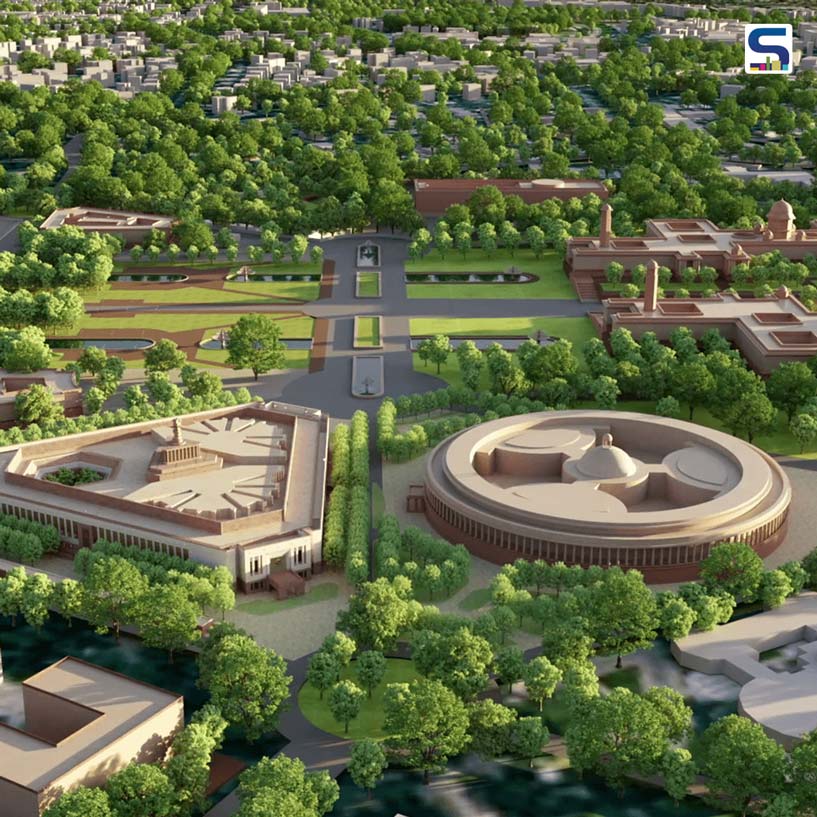
From sourcing materials from different corners of the nation to embodying sacred geometry and symbolisms rooted deep in the Indian cultural ethos, India’s new parliament building is one of its kinds SURFACES REPORTER (SR) reveals the fascinating details.
As we march towards the seventy fifth year of the Indian independence in the heart of the nation, a majestic symbol of progress and unwavering dedication to democracy emerges: the new parliament building. Designed as a sacred space for discourse and deliberation, it stands as a testament to the nation's unity and unwavering commitment to democratic principles.
Architect Bimal Patel, renowned for his expertise, spearheaded the design of the new parliament building. His esteemed firm, HCP Design, Planning and Management, serves as the design consultant for the comprehensive Central Vista redevelopment plan undertaken by the Central Public Works Department. Additionally, Tata Projects, a renowned name in the construction industry, took up the crucial role of the main contractor responsible for the flawless execution of this prestigious project.
Recently, Prime Minister Shri Narendra Modi had shared glimpses of the new parliament building on Twitter.
A Geometric Marvel
Gleaming with elegance, the building takes the form of a striking triangle, an embodiment of sacred geometry revered across religions. This geometric marvel serves as a visual ode to the three pillars of democracy: the executive, the legislature, and the judiciary. Crafted from resilient sandstone, it stands tall, embodying the strength and endurance of a nation steadfast in its democratic values.
The Symbolism of National Identity
As one steps inside, a tapestry of national symbolism unfolds, illuminating the spirit of India. The Lok Sabha chamber, adorned with the graceful presence of the national bird, the peacock, pays homage to the vibrant diversity that defines the nation. In the Rajya Sabha chamber, the gentle lotus, the national flower, serves as a gentle reminder of purity and enlightenment. The Central Lounge courtyard, resplendent with the sprawling branches of the banyan tree, reflects the deep-rooted unity and strength that binds the Indian people.
The Lion Roars
At the entrance, the national emblem of India stands proud, a four-headed lion embodying the mighty and unity of the nation. Resting upon the lotus, symbolizing purity and enlightenment, it serves as a resolute reminder of India's unwavering pursuit of progress.
The Diversity of Materials
The construction of the new parliament building of India involved sourcing materials from different regions of the country. Teak wood was procured from Nagpur, Maharashtra, while sandstone in red and white hues was sourced from Sarmathura, Rajasthan. Carpets found their way from Mirzapur, Uttar Pradesh, and bamboo wood flooring was acquired from Agartala, Tripura. Stone Jali works were obtained from Rajnagar, Rajasthan, and Noida, Uttar Pradesh.
To capture the essence of India's national symbols, the Ashoka Emblem was sourced from Aurangabad, Maharashtra, and Jaipur, Rajasthan, while the Ashok Chakra was brought in from Indore, Madhya Pradesh. Furniture components were procured from Mumbai, adding to the diverse origins of materials used. The construction materials themselves were sourced meticulously, with Lakha red granite hailing from Lakha in Rajasthan's Jaisalmer, Kesharia Green Stone from Udaipur, and Ambaji white marble from Ambaji in Rajasthan.
The intricate stone carving work was carried out by artisans from Abu Road and Udaipur, with stone aggregate sourced from Kotputali, Rajasthan. M-Sand was procured from Chakari Dadri in Haryana, while Fly Ash Bricks were obtained from NCR Haryana and Uttar Pradesh. Brasswork and pre-cast trenches were brought in from Ahmedabad, Gujarat, and the false ceiling steel structure above the Lok Sabha and Rajya Sabha came from the Union Territory of Daman and Diu.
The new parliament buildings represents the hopes and aspirations of a nation poised for a brighter future. Through a careful sourcing of materials from different parts of the country it serves as a testimony to the collective craftsmanship and contributions of various regions of India, uniting the country's diverse resources into a grand architectural achievement.